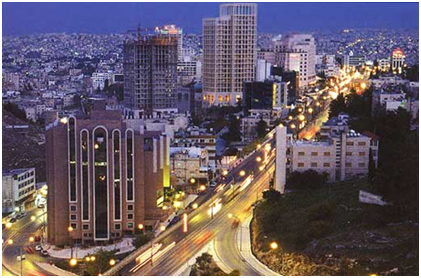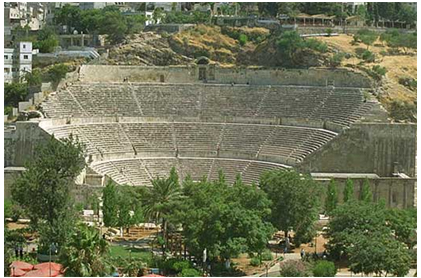 Amman, the modern and ancient capital of the Hashemite Kingdom of Jordan, is one of the oldest continuously inhabited cities in the World.
Amman, the modern and ancient capital of the Hashemite Kingdom of Jordan, is one of the oldest continuously inhabited cities in the World.
The city has two distinct parts: urbane Western Amman and earthy Eastern Amman. At the heart of the city is the chaotic, kinetic ‘downtown’.
Eastern Amman, including downtown, is home to the urbanized poor with vast suburban Palestinian refugee camps. Western Amman, looking to the Western way of life, is a world apart with its trendy cafés and bars, and impressive worldwide known art galleries. These two different faces of the city make it very tolerant and outward-looking.
Amman is definitely a modern Arab city embracing an international and culturally diverse vision of the future while boasting its magisterial Citadel, the remnants of ancient civilizations and spectacular Roman ruins.
 Amman was known in the Old Testament as Rabbath-Ammon, the capital of the Ammonites around 1200 BC, it was also referred to as “the City of Waters”.
Amman was known in the Old Testament as Rabbath-Ammon, the capital of the Ammonites around 1200 BC, it was also referred to as “the City of Waters”.
It was later conquered by the Assyrians, followed by the Persians and then the Greek Macedonians.
Ptolemy II Philadelphus, the Macedonian ruler of Egypt, renamed it Philadelphia (Greek for “brotherly love”).
The city was a part of the Nabataean kingdom until 106 AD when Philadelphia came under Roman control and joined the Decapolis League – a loose alliance of ten free city-states, bound by powerful commercial, political, and cultural interests under overall allegiance to Rome.
During the Byzantine period, Philadelphia was the seat of a Christian Bishop, explaining the presence of many churches in the area. The city declined somewhat until the year 635 AD.
As Islam spread northwards from the Arabian Peninsula, the land became part of its domain. Its original Semitic name Ammon or Amman was returned to it. Amman’s modern history began in the late 19th Century, when the Ottomans resettled a colony of Circassian emigrants in 1878. As the Great Arab Revolt progressed and the State of Transjordan was established, Emir Abdullah ibn Al-Hussein founder of the Hashemite Kingdom of Jordan made Amman his capital in 1921.
Amman remained a small city until 1948, when the population expanded considerably due to an influx of Palestinian refugees from what is now Israel.
The city’s population continues to expand at a rapid pace fueled by refugees escaping the wartime events in the West Bank and Iraq. The city received refugees from these countries on a number of occasions.
During the last 10 years the number of new buildings within the city has increased dramatically with new districts of the city being founded very rapidly (particularly so in West Amman) making Amman a modern, thriving metropolis of well over two million people.
